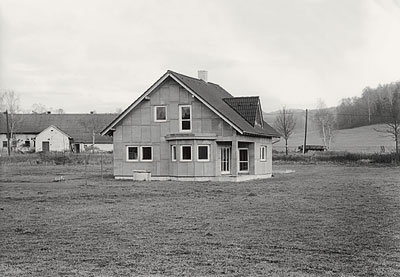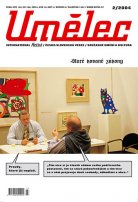| Umělec 2004/2 >> Gods Are Back Again | Просмотр всех номеров | ||||||||||||
|
|||||||||||||
Gods Are Back AgainUmělec 2004/201.02.2004 Arlene Tucker | en cs |
|||||||||||||
|
With Their New Masterpiece
I feel the need to introduce this series as a science project because that’s how I’ve grown to appreciate it most. The difference between this and a science experiment is that the viewer’s conclusion is ultimately irrelevant. A diagram by definition is a plan, a sketch, and a device for explanations, which stem into several paths. It’s one of the oldest forms of communication. The frescos in Lascaux and other ancient caves separate their drawings into themes of animals, human representation, and signs. The Egyptians told stories of the power of Gods, death, love and life through hieroglyphics. The uncoverings at Jiahu, China tell the cosmological importance of music. The photographs of Lukáš Jasanský and Martin Polák may not reveal the Paleolithic relationship with mastodons or woes of dune stricken blisters, but they evince an open interpretation of the peripheral villages near Prague, Czech Republic. Their role is to instigate the investigator in your thoughts of history with their documentations of that area and time. At first glance the pictures may seem unstimulating, too calm to consider a pounce, nearly reaching banality due to the stillness, but these precisely balanced compositions serve their purpose through desolation. These have been tediously designed to protrude all facets of life and intention through architecture. It’s refreshing to know that a dilapidated wall can exude an indescribable amount of warmth in this materialistic world. Within one flat, grey, fish-like scaly surface there are meshes of mortar, brash bricks that could sand down a thick callused foot and overgrown weeds that would antagonize any green thumb. Nonetheless, they titillate the eye with their softened edges and hand-laid cobblestones that only warn the visitor of a jing-jangly bicycle ride. This is just a superficial observation though, because once you’ve snugged that monocle into place and put the sift into action more elements of science begin to arise and investigation approaches. I previously said that these photos are quiet, still enough to catch the reverberations of a sneeze, but it’s not true at all. The lack of inertia is interrupted by statically charged weather stains. Now the texture on the walls fits the direction heard from the imagined rain. Arrows of erosion under the roof’s rim are a result of years and years of rain. The length of the arrows’ range helps us create depth and visualise how far the roof juts out to make shelter. Two-dimensional puffs out to three once observations of value and earth prance out together linked at the elbows. The remnants of snow brushed aside and halfway evaporated puddles mirror nature’s damage. Scientifically, these also refer to climate. The rain weathers paint away and peels the material leaving skeleton bricks, wooden planks, and iron supports exposed. This thwarts thoughts of clamminess. Dank air as in a steamy bathroom traps the valley’s humidity causing paint to peel away. The constant grey skies support this assumption. I was trying to elucidate some sort of symbolism with the greyness and conjured up only the most ridiculous answers, which I’m too embarrassed to share. They were evasive and elaborate so I decided to just ask the artists. Their response was honest and great: “There was no sun.” Immediately my senses are tapped and I’ve been fogged into the scene of the picture. From the medium grey shadows I can figure out the placement of the sun and feel it if I try hard enough. Knowing the exterior only rings curiosity to imagine the interior. I can only refer to the Czech houses I’ve visited, seen in films and other visual mediums of Eastern Europe. And of course of what previous history teachers have taught me. This holds true for every viewer too. Like a paint by number picture game I begin to fill in the geometrical planes with colour. A sort of bile-esque pink and minty green invade first. Then a floral patterned cloth that resembles poppy seed plants and babie’s breath with an embroidered edge drapes the heavy-set furniture of the 50s. Orange polka dotted tea sets that predominately clutter the shelves of bazaars appear in the kitchen cupboards. Suddenly I’m reaching for sugar in the thick glassed bucket that looks like a really deep shovel that’ll manhandle anything that moves. I almost poured flour from the neighbouring supliček into my tea. My solo company is broken by the chirp of a chicken following a knock from the baker’s wife whose marriage is written sweetly between doughy wrinkles. I start to subconsciously refer to the other photographs in the series, trying not to ruin the fluidity of stories with the reality of the tangible book in hand. It’s a shame that sense of touch can so often break the loftiness of daydreaming. The amount of life, the blood beating heart kind I mean, is rare, but this only enhances the relationship with the viewer. The roads of the village in mind winds with the one in the picture creating a map. They are worked around smooth pavement forking into a dirt path with a row of functionally designed houses. There is nothing ornate on the houses. The architecture of the roof is even a benefactor to action. The ergonomic reasoning for having steep slanted roofs is so that the snow falls faster, literally keeping the cold off the house. The diagonals create a momentum for… After much scrutiny I’ve come to realise that the vestiges can also be categorised into old, new, and presently operated actions. The old consists of finding broken windows that trigger thoughts of dumb birds and bored teenagers. Most birds are very intelligent, but some get too caught up in flying and fail to recognise the difference between a crisp landscape and a speck of dirt on glass that should have shouted a Stop sign in their world. “Honza!” yells Jarmila. “What’s in the building?” “I don’t know...just felt like throwing something.” And then walks apathetically towards the creek behind school. A curtain closes to the past and a window is left broken. The new category gets a bit complicated for it consists of reconstruction, demolishing, construction, and mounds of rubble both mini and big. These represent care. Even if the product is destruction somebody made a conscious decision to rip the existence apart. Teams of workmen will soon appear at dawn and the banging will surely scare the pigeons away. Hence the allusion to the broken window in the prior paragraph. I think out loud and exclaim, “I can’t wait till their lunch break so as to bring peace to these parts again. My ears ache.” Stains. Stains. Armpit stains and odours of sweat and garlic corrupt the air accordingly with the hastiness of the hammer. Finally, the present habitation category is pretty self explanatory. It represents the photos that have obvious life to them. Curtains, house numbers, well-built fences and gates, automobiles and such, support this section. What’s interesting about this observation is that the most cared for and elaborate places are the graveyard and what seems to be an official government building. The headstones are made of noble granite and accompanied by vases filled with freshly cut flowers. Even from this medium shot I see no wilting leaves only grateful caretakers. Ironically the graveyard is juxtaposed to an oblong wooden cubed vertically planked barn and a looming shadow of an unknown object in the bottom left-hand corner. This particular photograph exudes more movement and existence of life from the collaborative works of the dead that encourage the living to decorate. Gilded epitaphs. The government houses for the most part are plain, but the semi-elaborate art nouveau moldings and busts of important officials dramatise the buildings in a real mediocre kind of way. It looks boringly forced. This imbalance between ignored and spoiled walls leaves it looking like a bratty kid who refuses to bathe. Barren cement obviously shows the forced lack of care the architect reluctantly gave to this space that’s lined with desks and file cabinets. The attention to detail within this society amongst the deceased, the government and common people brings up a discussion that reveals their relationship. Concrete historical events of attack and rebellion from Communism and other periods can easily be paralleled with this assumption. They always say that one’s bedroom is a reflection of their insides and how their brain is organised. Even though we are only observing the facade it’s a hint of what can be further found indoors. Perhaps your hypothesis contradicts actuality, but it’s only the protrusion of thought that counts. I’ve proved myself right from the get-go that a diagram tangents off into a spider web of thoughts. Even the most linear of brains will get mangled looking at these buildings. So just allow the telephone lines to guide you and nostalgia stream out naturally. What seems minutiae will reveal itself as a ruminating detail so the only thing I suggest is to bring ample time.
01.02.2004
Рекомендуемые статьи
|
|||||||||||||









Комментарии
Статья не была прокомментированаДобавить новый комментарий